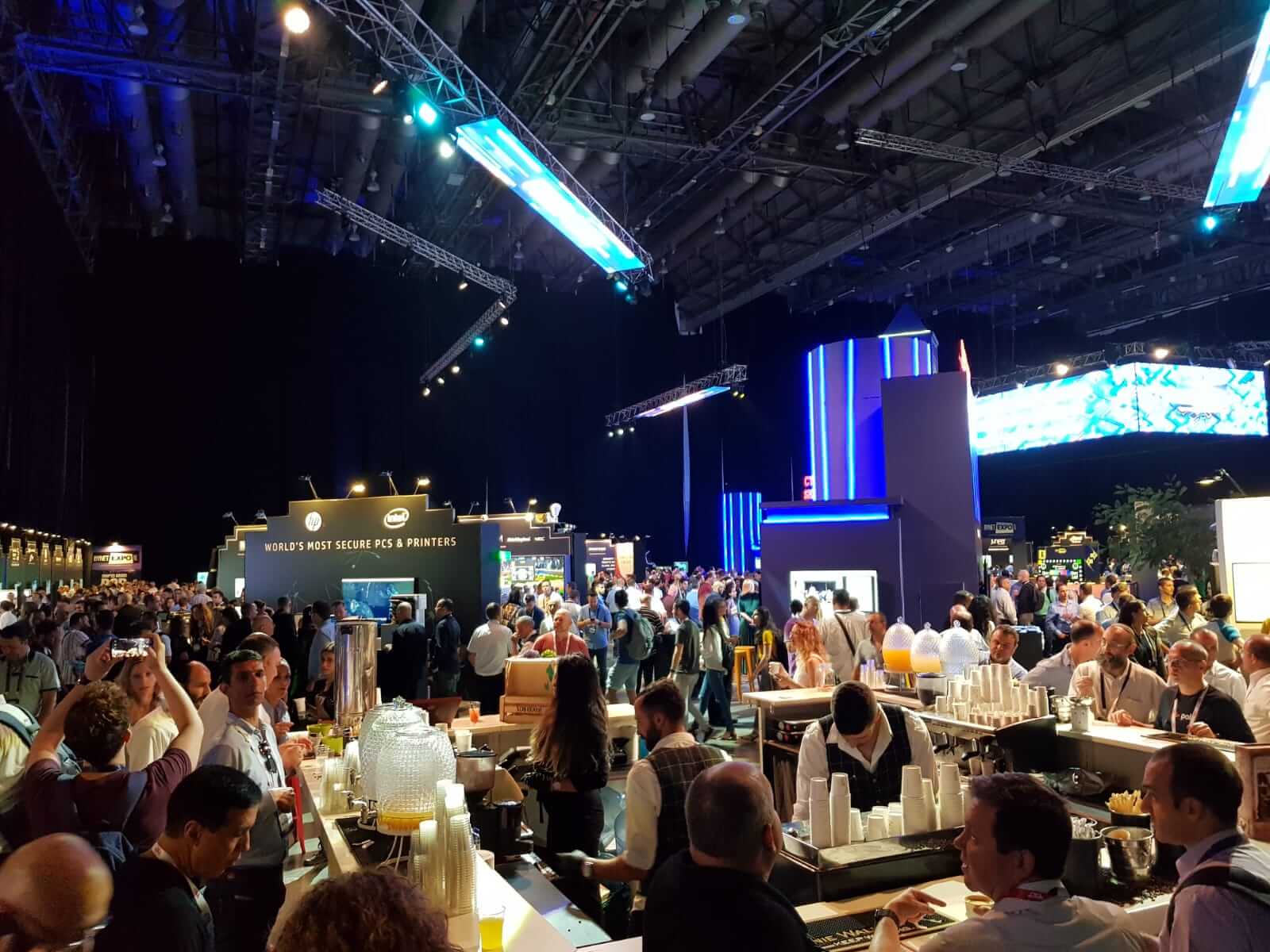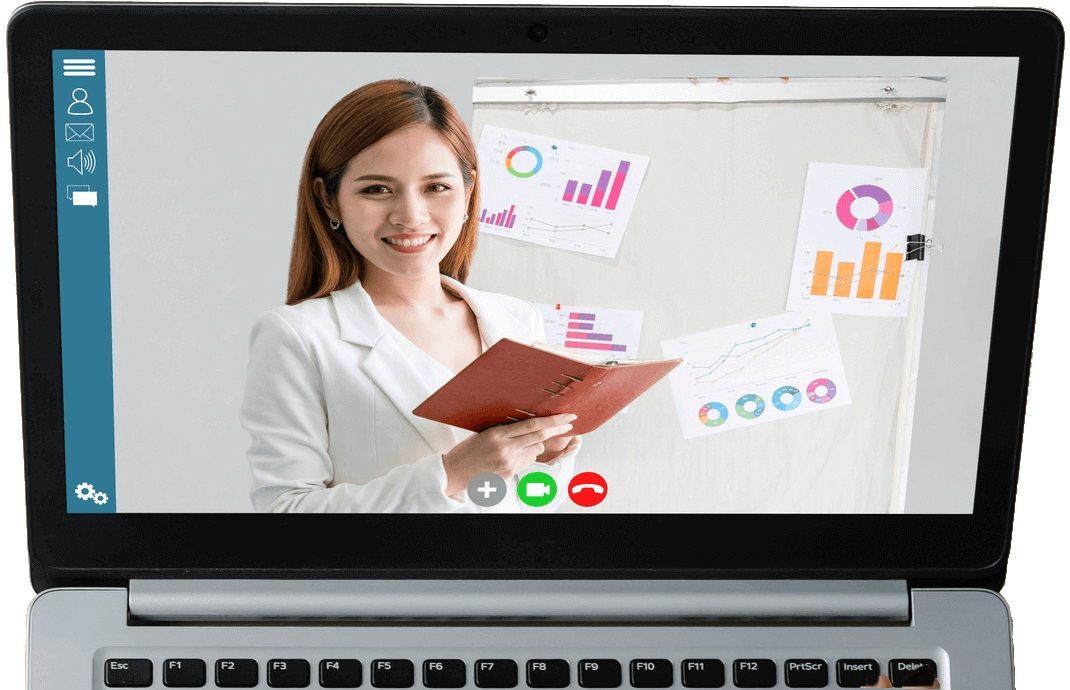December 31, 2020 | 9 min read
Virtual events have been growing in popularity for several years, and for 4 good reasons.
1) The technology behind virtual events has been constantly maturing to deliver engaging digital experiences that offer better returns on investment than participating in an in-person event.
2) Participants appreciate saving time and money by attending conferences remotely instead of having to travel.
3) The COVID-19 pandemic in 2020 raised concerns about international travel and participating in crowded events, pushing even more events online.
4) Rising anxiety over climate change and the trend for green/eco-friendly travel further raised the appeal of virtual events.
What Types of Virtual Events Are There?
A virtual event, or an online event, is an event that takes place online. Virtual events can include virtual concerts, online exhibitions, online conferences, professional webinars, and more. In the corporate world, virtual events generally mean an online conference, virtual trade show, or a webinar.
Webinars
Webinars are generally short, lasting anywhere from half an hour up to a couple of hours, and relatively smaller in size, with up to around 200 participants.
Webinars are generally not very interactive. Participants generally view and listen to a single expert speaker, or sometimes a panel of speakers. They might ask questions for the speaker to answer, but attendees don't expect to communicate with each other or even be able to see who else is attending.
Online Conferences
Online conferences tend to be both bigger and longer than webinars, with hundreds and sometimes thousands of attendees. Conferences usually take a minimum of 3 hours, but it's more common for them to last 8 hours or more, and to cover more than one day.
At conferences, participants expect to be able to interact with other participants in virtual venues like breakout rooms or virtual lounges. Conferences also typically offer a greater variety of content, with multiple talks taking place at the same time, as well as a variety of content types like interactive workshops, multi-speaker panels, and keynote talks.
Live video streaming is the heart of most virtual events. You cannot do without it. Thankfully all virtual event platforms support live video streaming in different levels of quality. To keep participants, engaged in the event video quality is important.
Virtual Academic Conferences
Also called scientific conferences, these are opportunities for researchers to present their most recent findings and share new ideas. The primary events are lectures and poster displays, where presenting authors, selected by the event committee, explain their research and conclusions to their peers. Academic conferences are generally hosted by academic organizations, professional societies, and trade associations to enhance cooperation and advance research. This being the case, the more that these conferences can be opened up to talented researchers around the world, the more valuable the results will be. Running academic or scientific conferences remotely can increase knowledge sharing and bring in more diverse opinions and perspectives.
Virtual Business Conferences
Business conferences are held by event organizers, media groups, and industry bodies to bring together stakeholders, innovators, and thought leaders within their industry or vertical. Such events aim is to discuss industry trends, draw attention to industry issues, improve networking relationships, and expose participants to business opportunities.
Online trade shows and exhibitions
 Also known as a virtual trade show or trade fair, this is an event where industry partners can show and demonstrate their products and services to potential customers. A virtual exhibition can accompany a virtual conference, with speakers and workshops, or it can stand alone like a trade show, careers fair, or higher education fair.
Also known as a virtual trade show or trade fair, this is an event where industry partners can show and demonstrate their products and services to potential customers. A virtual exhibition can accompany a virtual conference, with speakers and workshops, or it can stand alone like a trade show, careers fair, or higher education fair.
Lectures by industry leaders are a great incentive to bring more people to the online exhibition, while a virtual "exhibition hall" accompanying lectures enables companies, professional bodies, or organizations to showcase their business and make valuable new connections.
A trade show is mostly financed by exhibitors and sponsors.
Hybrid Events
Most kinds of in-person events can also be a hybrid event, meaning that some of the participants are present in person while others join the action online. Consider that most major sports events are already hybrid events, with many more people tuning in remotely than the number who attend in person. For sports events, remote fans have a bigger impact on revenues from sponsorship than those who are physically present at the event.
Hybrid events have many advantages. They can make it easier for you to scale up your event to reach thousands of more people than could participate in person, plus they allow individuals to join in even if they can't travel to the venue. Several popular tech conferences offered both in-person and remote tickets long before COVID-19 arrived because they couldn't find physical venues big enough for everyone who wanted to attend.
On the flip side, hybrid events mean that attendees watching from a distance can benefit from the energy that results from in-person interaction between a speaker and an audience. The famous TED talks include a small physical audience who provide real-time feedback like laughs and gasps, but the online audience is far wider.
Hybrid events allow event planners to promise more exposure to sponsors and exhibitors, thereby sharpening their proposal without adding significantly to the cost of the event.
What Are Virtual Event Platforms?
A virtual event platform is a software solution that hosts your virtual event and manages the technical side of the proceedings. Even though every participant views your event through their screen, it has to be hosted in a specific online location so that attendees can log in, interact, and stream or download the content. Because it's hosting your virtual event, it's also called the virtual event venue.
Some event planners find it more stressful to organize virtual events because they feel that they have less control over the proceedings. With virtual events, much more depends on technical issues like internet connectivity, and it's harder to manage participants from a distance. Virtual event platforms can help with this.
Live Video Streaming – The Cornerstone of Virtual Events
Live video streaming is the heart of most virtual events. You cannot do without it. Thankfully all virtual event platforms support live video streaming in different levels of quality. To keep participants, engaged in the event video quality is important. Bad sound quality, blurry images, or jerky video can turn most relevant away. High video and sound quality can help make the remote participating experience thrilling.
- What are the video quality aspects you can control?
- a. Video source quality – Lighting and camera quality.
- b. Video resolution – 4K, Full HD (1080), HD (720), Standard (SD / 480)
- c. Video encoding and distribution.
Combine Multiple Dedia and Video Sources
Online events usually involve more than just one speaker. To create an engaging experience the event organizer, need to able to combine different video sources and experiences. A recorded lecture followed by a live lecture or live Q&A session, a panel of speakers., a demo, a video clip, or a live poll. These elements
If you plan to mix media, like switching between live speakers and prerecorded video segments, sharing images, including interactive content like live polls, or inviting questions from attendees, virtual event platforms help you transition smoothly between each element.
Online Events Access Control and Security
 Whether you're selling tickets to your virtual event or attendance is free of charge, access control to the event is a must. Spammers, trolls, and fake users can disrupt online events, annoy and deceive other participants and damage the event organizer's reputation so it's important to be able to prevent access from unwanted guests and being able to block unwanted behavior.
Whether you're selling tickets to your virtual event or attendance is free of charge, access control to the event is a must. Spammers, trolls, and fake users can disrupt online events, annoy and deceive other participants and damage the event organizer's reputation so it's important to be able to prevent access from unwanted guests and being able to block unwanted behavior.
Access control also means event organizers get a better insight on who participated, which segments were the most engaged, which lectures were more popular, and other data that can help you improve the next event.
Having moderated chats, pre-approve messages before they are published, and reviewing participant's videos stream before publishing them means organizers can ensure discussion reminds productive and abuses cannot divert discussions to non-relevant topics.
Maximize Marketing Impact
Built-in marketing tools like lead capture apps also help you make more out of your virtual event. You can usually use the same virtual event platform to live-stream the event, and then make it available on an on-demand basis after the event
Where Should You Record Your Online Event Content??
When it comes to recording content for your event, you'll want to work with speakers ahead of time to make sure that their camera, microphone, and internet connection are good enough. This can have a dramatic effect on the participant experience. You'll also need to ensure that they reduce background noise and have a background that isn't distracting or that undermines your brand.
In many cases, you can achieve better results and enjoy better peace of mind by using a professional studio, whether you're prerecording it or broadcasting it live. A studio is equipped with professional lighting, optimal acoustics, high-quality microphones, and multiple cameras so you can flip between different views of the speaker(s), as well as fully-trained operators and sound and video engineers who help edit your recorded content.
If you plan to hold more than one or two virtual events, you might find it worthwhile to create your studio within your business premises. You will need:
- ● At least one camera that connects to a computer
- ● Live video editing software such as OBS (free) or VMIX
- ● A quiet room
- ● Good lighting without reflections from windows
- ● A reliable, high-speed internet connection of at least 10 Mbps upload
How can you brand your virtual event venue?
It's just as important to brand your virtual events as it is to share branding on your physical, in-person events. This is especially crucial for longer events since you want participants to spend a lot of time with your brand.
You want to boost your brand messaging, so make sure that your logo is prominently displayed on the backdrop behind the speaker, and on the table and/or microphones that are visible in the videos. It's a good idea to arrange backdrops, tablecloths, or other items in your brand colors, too. Depending on your virtual event, it's also possible to send branded goody-bags and/or props to all the participants in advance.
Video Types for Virtual Events
Another important thing to consider is whether your virtual event should be live, prerecorded, pre-recorded but played as a live stream, or a mix of the three options.When lectures are delivered as live streams participants feel part of the event as it happens, attendees can ask questions and get answers in real-time. Speakers can also ask questions and post online polls that influence the rest of the lecture. Live lectures are more interactive, engaging, and generate more comments. Also, it may sound strange for people who did not get to record a lecture, but actually, live video is easier and faster to produce, no files, no editing is required and some imperfection is accepted. Finally, the result. according to data from Facebook, live video is watched for 3 times longer time than recorded video and generates 10 times more comments. The downside to live lectures is the technical and logistical risks involved. The speaker has to show up on time, have a reliable internet connection, give the lecture from a quiet room, use a good enough camera, quality microphone, and good lighting. While most of those things can be validated in advance, in real life sometimes things break.
Prerecording event lectures gives organizers and speakers peace of mind and more flexibility, they can schedule the lecture recording freely. Once the lecture is recorded the Event organizer does not need to worry about the speaker being ready and other technical issues connecting with the speaker. The event organizer can edit the video, go back and record again if anything goes wrong, remove pauses, and add infographics to demonstrating lecture concepts and making the lecture easier to understand and follow. Also, the exact lecture time is known in advance which helps keep the event timeline on track.
Sharing recorded lectures in a video on demand (VOD) format means that participants can start and pause the event whenever it's most convenient for them. It also means participants are not watching the lecture together – at the same time. So many opportunities for interaction between participants are gone. Asking questions and interaction with speakers is technically possible but participants tend to avoid this because there is little chance, they will get an answer or little chance for effective conversions. Still, VOD is could be great add-ons for many events letting participants view lecture recording after the event at their convenience.
Playing recorded video live means the lecture is pre-recorded but it plays as a live video. This brings out many of the benefits from live lectures with the reduced risk that pre-recorded lectures bring. Participants watch lectures together; they can interact with each other based on the lecture, comment, and ask questions. The speaker can be online and answer those questions in the chat or appear after the recording and answer the questions live.
Building the event agenda using both live lectures and live streaming of pre-recorded lectures has benefits. `The speaker is on hand to answer questions live, but the main talk was prerecorded to reduce the risk of mistakes and glitches.
Your choice between live, VOD, and live streaming recorded material can make a difference to whether you prefer to go to a virtual event venue or use the speakers' webcams and microphones.
Audience Retention – The Challenges of Virtual Events
 Arranging a knockout event is always a challenge, but they mount up even higher when your event is virtual. Its common knowledge that attention spans are getting shorter. According to a study done by Microsoft in 2015, the average human attention span was 8 seconds in down from 12 seconds in year 2,000. It's clear that most people today are flooded with information, flooded with options, and have too much to do. Sitting in front of a computer or with their phone is in their hand's participants can go somewhere else with a click of a button.
The biggest challenge virtual event organizers face is keeping participants engaged for a long time when they go away so easily.
Arranging a knockout event is always a challenge, but they mount up even higher when your event is virtual. Its common knowledge that attention spans are getting shorter. According to a study done by Microsoft in 2015, the average human attention span was 8 seconds in down from 12 seconds in year 2,000. It's clear that most people today are flooded with information, flooded with options, and have too much to do. Sitting in front of a computer or with their phone is in their hand's participants can go somewhere else with a click of a button.
The biggest challenge virtual event organizers face is keeping participants engaged for a long time when they go away so easily.
- Here are few things that can help retain participants engaged:
- ● Keep sound and video quality high - participants lose interest fast when sound is not clear.
- ● Allow participants to multi-task - browse through related material and chat, network with other participants, and check other event halls while watching a lecture.
- ● If possible, keep lectures short.
- ● Allow participants to lean backward and enjoy a TV-like experience – Participants that are leaning backwards will stay for longer period of time If you force participants to click some will go away.
- ● Encourage speakers to embed video clips and graphics media into their talks. Prerecorded video clips, animations, images, or data visualizations can make things cleaner and more interesting.
- ● Encourage speakers to repeat key information in different ways.
- ● Lighten up – Make good use of humor, off subject stories and some gossip to keep participants engaged.
What's Next?
Virtual event platforms can deliver excellent digital experiences that provide as much (or more) value as in-person events. Are you ready to plan your next virtual event? Eventact is ready to help you. Our event management platform is at your service to host and support every kind of virtual event, big or small.
Get in touch to talk with us about your next virtual event or request a demo.
Read more about the Eventact Virtual & Hybrid Events Management platform here.